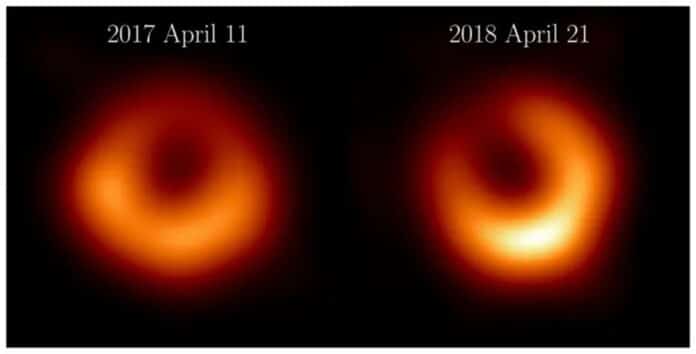The Event Horizon Telescope (EHT) Collaboration has unveiled fresh images of M87*, the supermassive black hole in the galaxy Messier 87, using data collected in April 2018. These observations, which involved the newly operational Greenland Telescope and a significantly enhanced recording rate across the array, provide a new perspective on the source compared to the initial observations in 2017.
A recent study showcases the latest images from the 2018 data, revealing a ring structure similar in size to the one observed in 2017. This bright ring encircles a deep central depression, known as “the shadow of the black hole,” consistent with predictions from general relativity.
What’s particularly exciting is that the brightness peak of the ring has shifted by approximately 30 degrees compared to the images from 2017. This shift aligns with our theoretical understanding of variability resulting from turbulent material surrounding black holes.
Dr. Keiichi Asada, an associate research fellow at Academia Sinica Institute for Astronomy and Astrophysics in Taiwan, said, “A fundamental requirement of science is to be able to reproduce results. Confirmation of the ring in a completely new data set is a huge milestone for our collaboration and a strong indication that we are looking at a black hole shadow and the material orbiting around it.”
In 2017, the Event Horizon Telescope (EHT) captured the first-ever image of a black hole, specifically M87*, located at the center of the galaxy Messier 87, 55 million light-years away from Earth. The image revealed a bright circular ring, with the southern part brighter. Further data analysis provided insights into the magnetic field’s geometry and the plasma surrounding the black hole.
This breakthrough marked the beginning of a new era in black hole astrophysics, enabling tests of general relativity at a fundamental level. The EHT’s continuous development, including adding the Greenland Telescope in 2018, has enhanced image fidelity and coverage.
The participation of the Large Millimeter Telescope, upgraded frequency bands, and improved sensitivity contribute to advancing our understanding of black hole astrophysics. Multiple observations of M87* will provide independent constraints on its plasma and magnetic field structure, aiding in untangling complex astrophysics from the effects of general relativity.
Rohan Dahale, a PhD candidate at the Instituto de Astrofísica de Andalucía (IAA-CSIC) in Spain, said, “Advancing scientific endeavors requires continuous enhancement in data quality and analysis techniques. Including the Greenland Telescope in our array filled critical gaps in our earth-sized telescope. The 2021, 2022, and the forthcoming 2024 observations witness improvements to the array, fueling our enthusiasm to push the frontiers of black hole astrophysics.”
The analysis of the 2018 data incorporates eight independent imaging and modeling techniques, including both previous methods used in the 2017 analysis of M87* and new ones developed from analyzing Sgr A*.
The image of M87* captured in 2018 resembles the one from 2017. It depicts a bright ring of consistent size, featuring a dark central region and one side of the ring brighter than the other. According to general relativity, the mass and distance of M87* remain relatively constant over a human lifetime, predicting that the ring diameter should remain unchanged from year to year. The stability of the measured diameter in the images from 2017 to 2018 strongly supports the conclusion that M87* behaves as predicted by general relativity.
Although the size of the black hole shadow remained constant between 2017 and 2018, there was a significant change in the location of the brightest region around the ring. The bright region shifted approximately 30 degrees counterclockwise to settle at the bottom right part of the ring, roughly at the 5 o’clock position. Previous observations of M87* with less sensitive arrays suggested yearly changes in the shadow structure, albeit with less precision.
While the 2018 Event Horizon Telescope (EHT) array still cannot directly observe the jet emerging from M87*, the black hole’s spin axis predicted from the location of the brightest region around the ring is more consistent with the jet axis observed at other wavelengths.
Dr. Britt Jeter, a postdoctoral fellow at Academia Sinica Institute for Astronomy and Astrophysics in Taiwan, said, “The biggest change that the brightness peak shifted around the ring is something we predicted when we published the first results in 2019. While general relativity says the ring size should stay pretty fixed, the emission from the turbulent, messy accretion disk around the black hole will cause the brightest part of the ring to wobble around a common center. The amount of wobble we see over time is something we can use to test our theories for the magnetic field and plasma environment around the black hole.”
Hugo Messias, Leader of VLBI observations at ALMA said, “Although the weather conditions in 2018 were worse than in 2017, the EHT could still confirm the ring morphology in M87* in this new observation one year later. Part of this feat was that new stations were in place, improving the image fidelity, and a wider frequency range was covered while ALMA remains the main steering station in the network.”
“The apparent wobble of the bright spot in the image agrees with expectations for a turbulent environment around M87 while still in the presence of an ordered strong magnetic field. This year, we plan to observe M87 at even higher frequencies, hopefully providing more detail in the ring. So, we are now counting down to those observations and consequent results.”
Journal Reference:
- I. Observations, calibration, imaging, and analysis. The persistent shadow of the supermassive black hole of M 87. Astronomy and Astrophysics. DOI: 10.1051/0004-6361/202347932
